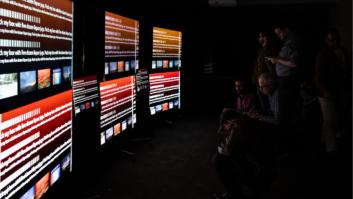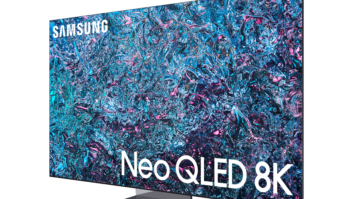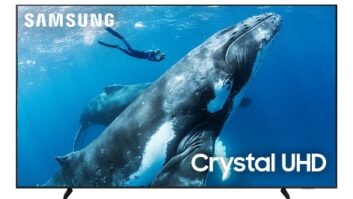We’ve all seen a movie or TV show where, at some point along the line, someone has only seconds to deactivate a bomb, but they don’t know how. “Is it the red wire or the blue wire?” or words to the effect are the typical dialog. Incredibly, they almost always pick the right one without help from the bomb squad and everyone lives happily ever after. While this summary from last month’s International Consumer Electronics Show (CES) may not have the same dramatic impact, the notion of “which to choose, “this or that?” is a good theme to use in looking at some of the products and technologies that were on display in Las Vegas in early January.


With HDMI 2.0 limited to 2160/60p/4:4:4/8-bit, or 2160/60p/4:2:2 up to 12-bit color, some brands at CES were looking ahead to the demands of 8K sets, even though their practical availability for consumer use is still a few years down the road. In some cases it is a “this or that?” decision where you have to decide on which implementation of a technology to go with. In other cases it is a “red wire/blue wire” scenario. In yet others, you simply accept what is there if you want it as there is no other choice. Yes, CES 2015 was like that.
HD or 4K/UHD?
One could say that that “HD or 4K/UHD” is one place where a choice has to be made, but all indications are that given the rampant price compression for consumer video displays most of the sets you will spec into jobs above 55 inches will be 4K. Fine, but once that decision is made, CES 2015 brought a number of decision points to the fore, particularly at the higher end of the market and for larger screens sizes that will be prevalent in the custom world.
Curved or Flat?
The curved vs. flat video choice is somewhat of a toss-up, as the post-CES dividing line has it mostly with the Korean brands (LG and Samsung) favoring curved, while the remaining Japan-based brands (Sony, Panasonic, and Sharp) offer flat screens. I say a toss-up because technical considerations aside, this often becomes a personal taste decision. However, if you or your client have other reasons to go with, say Samsung’s new S-UHD models, then your choices are curved or curved; flat is not an option. If you like the features and performance of an LG or Samsung set, then it’s curved or nothing, and clearly the other way around if you favor a Sony, Panasonic, and Sharp but really want that curved look.
On the fence about “flat vs. curved”? Both Samsung and LG once again showed “bendable” sets that can switch between the two screen surface types, but at a huge price. A novelty, to be sure, but for any number of reasons we’ll suggest that you pick curved or flat as best fits a given installation and stick with it.
Is HDR for Real?
In terms of technology cores, two aspects of the display world were all over the map at CES. High Dynamic Range, or “HDR” was claimed as a component of the feature set of products from virtually all the major brands, but a few words on the choices are in order. Most importantly, to have a complete HDR system the content must be graded to HDR and carry the metadata to describe what is going on. Then, on the display side, the set must have the processing and software required to recognize that HDR content is present, then deal with it accordingly.
That does lead to one of our decision points, as HDR is currently in two stages. The mildest is in the “HDR-like” processing included in many 4K displays from all the majors, but this is a one-way, close-ended situation where the set does processing to improve contrast and dynamic range, but there is nothing in the content, itself, to direct the set as to what to do. Nothing wrong with that, as there is some benefit, but it’s either there or not in the way the brand dictates. As always, when judging sets, turn this feature on and off to see if the difference is worth any extra cost, and to see if the way one set does it is better than another.
Where the choices will have to be made is when the studios, broadcasters and streaming delivery services begin to offer content specifically created to use one of the end-to-end systems in the market now such as Dolby Vision and those from Technicolor, Philips, and others. When that happens, you’ll have to see which standards are available on the content delivery side, which sets offer what, and then the decision will be required.


The curved vs. flat video choice is somewhat of a toss-up, as the post-CES dividing line has it mostly with the Korean brands (LG and Samsung) favoring curved, while the remaining Japan-based brands (Sony, Panasonic, and Sharp) offer flat screens. Regarding HDR content, Netflix announced that it will be using HDR on some of both of its HD and 4K content this year, but it did not say which system it will use. Next, Dolby Vision was shown in sets from TCL and Hisense, with other brands rumored to be on deck. Complementing that, Warner Home Video announced during CES that it will use Dolby Vision with a number of Bluray releases in 2015.
Finally, and perhaps most importantly, there are two standards-related aspects of the HDR decision. The new UltraHD Blu-ray standard, or if you will, “4K for optical discs” will mandate compatibility with HDR, but at least as of this time, no specific standard has been selected. Indeed, the standard only says that HDR must be accommodated, but its presence is not required. Add to that the announcement during CES of the formation of the “UHD Alliance.” This group of major set manufacturers (Sony, Sharp, Panasonic and LG), IP licensors (Dolby and Technicolor), and suppliers and distributors (Netflix, DirecTV, Disney Studios, Warner Bros. Entertainment and 20th Century Fox) have agreed to work on setting standards for key parts of the 4K/UHD eco-system and HDR is clearly one of those components. Will either of these announcements eliminate the need for you and your clients to make decisions on key technologies and concentrate instead on how one product or another implements them? Stay tuned, as this will be an interesting one to watch.
What’s Up with OLED and Quantum Dots?
At the upper echelon of 4K sets you’ll likely have to explain, if not demonstrate, the merits and benefits of both OLED and Quantum Dots, two technologies that are billed by some brands as “non-crystals” because both terms describe technologies. There is little question that both deliver images better than the conventional LED edge-lit LCD displays that have all but replaced CCFL-illuminated displays. However, the “this or that” question you will be asked by a client or prospect sooner than later is “Which do you recommend?” or “Why are you recommending that I buy this one over that one?” Good questions.
As an emissive technology, OLED will have the edge on contrast since when a pixel is off it is really “off” with no light coming through to the screen. Quantum Dots/Nano-Crystals can come close depending on the light source used, but off is never COMPLETELY “off”. However, when you mix in one of the various HDR schemes the comparison is a close one and the choice may come down to dollars. At least for now, OLED is still somewhat pricy and Quantum Dots a bit less so. Our suggestion: see what your lines offer and do your own comparison so that you can speak to this question from first-hand experience.
Just to make things interesting, one of the more under-reported display technologies shown at CES that may provide another option at some point during the year is a hybrid laser/LED screen shown by P&F, the marketing company selling products under the Philips brand in the U.S. This set uses a red laser in combination with cyan LEDs to illuminate the screen, and the result was interesting. The colors were certainly vivid, though perhaps in need of calibration, and the contrast was almost as good as OLED. Should this set make it to distribution it will likely be priced in between the typical Quantum Dot and OLED sets, giving you one more choice to consider.
What are 4K Source Options?

At the upper echelon of 4K sets you’ll likely have to explain, if not demonstrate, the merits and benefits of both OLED and Quantum Dots, two technologies that are billed by some brands as “non-crystals” because both terms describe technologies. The options for native 4K content to play on these sets also increased at CES 2015, and here the decision involves a bit of consumer choice as it is “satellite vs. cable vs. servers vs. streaming,” with a new optical disc format finally on the tracks to arrive this year.
Most new UHD sets (projectors excluded) have some level of streaming service capability along with the HEVC and VP9 codecs required to handle them. Netflix is almost standard, with many brands also offering Amazon’s 4K content as well as UltraFlix, an independent service with a wide range of movie, documentary, and other content, along with some free 4K material that will serve you well as demo material. For these services it is either a “the set has it or it doesn’t.”
When it comes to servers, Sony’s unit is an obvious choice, again for “app-less” projectors, as is Nanotech’s Nuvola NP-1 that offers its own UltraFlix service. The “this or that” here is that both satellite services will offer 4K content delivery this year, albeit taking different approaches. DirecTV will use RVU’s technology to bring the 4K content from their Genie STB to select sets (Samsung only at the moment) via IP. Taking a different approach, Dish will soon offer a 4K-capable Joey product that works within their ecosystem to deliver 4K content to any set with HDMI 2.0 and HDCP 2.2. For systems with an AVR or surround processor not equipped for HDCP 2.2, as some current models are, there is an optical digital output for multichannel audio. Unfortunately there is no clear choice here, as this is service, set, and customer preference dependent.
A standard is reported to be in the final stages of approval that will make it possible for us to see Bluray players and content before the end of the year for 4K native content delivery. The new UltraHD Blu-ray format will have more than sufficient storage capacity and fast enough data throughput to make it possible for the “broadband impaired” to have the content that matches the capability of their displays. Panasonic had a prototype unit at CES, but the reality check here is no longer “if,” but “when?” With some standards items still to be ratified and an infrastructure created a late 2015 appearance is reasonable, but not 100-percent certain.
How to Connect It All Together
Another somewhat under-reported story from CES 2015 was the announcement of superMHL. To date HDMI, it’s big brother, has been the defacto standard for virtually all in-home digital audio/ video connections with only a small percentage of computer-based systems using DisplayPort. MHL? You may have run into it as a way to connect an Android smartphone or tablet to a home system or perhaps with the original version of Roku’s Streaming Stick. Now, all that is going to change.
With HDMI 2.0 limited to 2160/60p/4:4:4/8- bit, or 2160/60p/4:2:2 up to 12-bit color, some brands are looking ahead to the demands of 8K sets, even though their practical availability for consumer use is still a few years down the road. Given that they do have potential for retail display/digital signage as well as for things such as medical imaging and similar scientific and design applications, the forward thinking as to how they will connect to sources has begun.
The requirements of 8K with the possibility of content sporting 7680×4320 at up to 120fps with 16- bit color vastly dwarf what HDMI 2.0 can handle. Anticipating the need perhaps even before there is anything to connect, superMHL purports for offer an option. Included in the spec is 40W charging for multiple or higher power-hungry tablets or source devices as well as a symmetrical connector that will eliminate the “up or down” insertion question we face not only with HDMI, but also with most USB connections.
In a perfect world, the proposed features would make it an easy choice, but the reality is that this isn’t a “this or that?” decision you could make right now even if you wanted to. The connectors, cables, and the chips that make superMHL possible aren’t available yet, nor are they likely to be for some time.
Given the time line before superMHL will be fully implemented into products, you can certainly be assured that neither the HDMI or DisplayPort groups will throw in the towel. In response to our questions on this, a representative for the HDMI side of things was very clear in stating that when the time is right and the need present, HDMI will have their own response to the requirement for 8K connectivity. After all with “billions and billions served” on can’t imagine them just letting someone else take their market share without a good fight.
Of course, CES is more than just audio and video. With more booths and floor area than one can possibly see in only four days or report in one article there were loads of “this or that” choices in the worlds of IoT/Connectivity/Automation, audio and mobile products. However, as our space for this month has run out we’ll have to leave those topics to our fellow RS correspondents and our own future columns. For now, take in all the reports from CES and look closely at all sides of the product and technology decision fences. To make life simpler and better for your clients CES 2015 points to some complex technology choices that you’ll have to evaluate and make properly.
Michael Heiss is a Sherman Oaks, CA-based contributing editor to Residential Systems.







